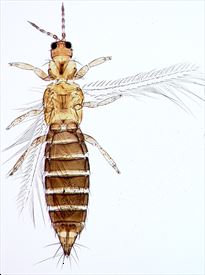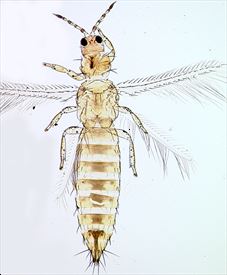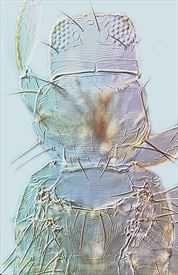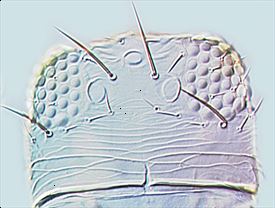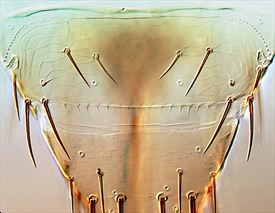Distinguishing features
Both sexes fully winged. Female colour variable from yellow to brown, widespread pest strain mainly dark yellow with brown areas medially on each tergite; antennal segments II & VI–VIII brown, III–V yellow with apices variably brown; legs mainly yellow washed with brown; fore wings pale with dark setae. Antennae 8-segmented, III–IV each with sense cone forked, VIII longer than VII. Head wider than long; 3 pairs of ocellar setae present, pair III longer than distance between external margins of hind ocelli, arising on anterior margins of ocellar triangle; postocular setae pair I present, pair IV longer than distance between hind ocelli. Pronotum with 5 pairs of major setae; anteromarginal setae slightly shorter than anteroangulars, one pair of minor setae present medially between posteromarginal submedian setae. Metanotum with 2 pairs of setae at anterior margin, campaniform sensilla usually present. Hind coxae without any microtrichia on dorsal surface. Fore wing with 2 complete rows of veinal setae. Tergites V–VIII with paired lateral ctenidia, ctenidia sometimes weakly developed on IV, on VIII anterolateral to spiracle; posteromarginal comb on VIII complete, with short slender microtrichia arising from triangular bases. Sternites III–VII without discal setae.
Male similar to female but smaller and paler; tergite VIII without marginal comb; IX with median pair of dorsal setae shorter than lateral pair, posterolateral setae stout in larger males; sternites III–VII with transverse pore plate.
Related species
Only two species of Frankliniella are currently recorded from New Zealand: F. occidentalis and F. intonsa, but F. panamensis is frequently intercepted by New Zealand quarantine inpection services. These three are very similar to each other but the postocular setae are considerably longer in occidentalis and panamensis, and the metanotum usually (but not always) has paired campaniform sensilla. Frankliniella species all have a pair of setae in front of the first ocellus, a complete row of setae on both veins of the fore wing, and a pair of ctenidia on tergite VIII situated anterolateral to the spiracles. Most of the 230 described species are known only from the neotropics, but F. schultzei and F. occidentalis have been widely introduced around the world (Kirk & Terry, 2003). F. occidentalis can usually be recognised by the pale fore wings, long postocular setae, presence of metanotal campaniform sensilla, and the rather irregular comb on tergite VIII. However, this species is variable in size and colour, the dark brown form being more common at low temperatures, and the pale yellow form at higher temperatures, but the widespread pest strain is usually more constant in size and colour. Molecular studies have indicated that Western flower thrips comprises two species that cannot be distinguished morphologically (Rugman-Jones et al., 2010).
Biological data
This is a highly polyphagous pest that feeds and breeds on leaves and within flowers. It causes feeding damage on developing fruits, and is also an important vector of tospoviruses on many crops. However, it also feeds on leaf mites of which it can be a useful biocontrol agent. In New Zealand the lupin strain of F. occidentalis is mainly restricted to the yellow tree lupin (Lupinus arboreus).
Distribution data
Originally western USA, but now worldwide in temperate areas. In New Zealand usually found only as a pest within greenhouses.
Family name
THRIPIDAE, THRIPINAE
Species name
Frankliniella occidentalis (Pergande)
Original name and synonyms
Euthrips occidentalis Pergande, 1895: 392
Euthrips tritici californicus Moulton, 1911: 16
Euthrips helianthi Moulton, 1911: 40
Frankliniella tritici moultoni Hood, 1914: 38
Frankliniella nubila Treherne, 1924: 84
Frankliniella tritici maculata Priesner, 1925: 15
Frankliniella claripennis Morgan, 1925: 142
Frankliniella canadensis Morgan, 1925: 143
Frankliniella trehernei Morgan, 1925: 144
Frankliniella occidentalis brunnescens Priesner, 1932: 182
Frankliniella occidentalis dubia Priesner, 1932: 182
Frankliniella venusta Moulton, 1936: 172
Frankliniella conspicua Moulton, 1936: 173
Frankliniella chrysanthemi Kurosawa, 1941: 173
Frankliniella dahliae Moulton, 1948: 97
Frankliniella dianthi Moulton, 1948: 98
Frankliniella syringae Moulton, 1948: 98
Frankliniella umbrosa Moulton, 1948: 105
References
Gunawardana DN, Li DM, Masumoto M, Mound LA, O’Donnell CA & Skarlinsky TL. (2017) Resolving the confused identity of Frankliniella panamensis (Thysanoptera: Thripidae). Zootaxa 4323 (1): 125–131.
Hoddle MS, Mound LA, Paris DL (2012) Thrips of California2012. CBIT Publishing, Queensland. http://keys.lucidcentral.org/keys/v3/thrips_of_california/Thrips_of_California.html
Kirk WDJ & Terry LI (2003) The spread of the Western flower thrips Frankliniella occidentalis (Pergande). Agricultural and Forestry Entomology 5: 301–310.
Rugman-Jones PF, Hoddle MS, & Stouthamer R (2010) Nuclear-mitochondrial barcoding exposes the global pest Western flower thrips (Thysanoptera: Thripidae) as two sympatric cryptic species in its native California. Journal of Economic Entomology 103: 877–886
Teulon DAJ & Nielsen MC. (2005) Distribution of Western (glasshouse strain) and Intonsa flower thrips in New Zealand. New Zealand Plant Protection 58: 208–212.

